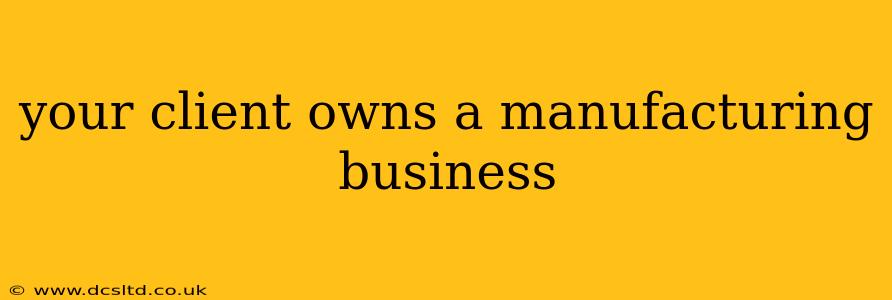Boosting Your Manufacturing Business: A Comprehensive Guide to Growth and Success
The manufacturing landscape is dynamic and competitive. To thrive, your manufacturing business needs a robust strategy encompassing production efficiency, marketing prowess, and a keen understanding of market trends. This guide delves into key areas crucial for boosting your manufacturing business, offering insights and actionable strategies to help you achieve sustainable growth.
Understanding Your Manufacturing Business's Unique Position
Before diving into specific strategies, it's crucial to understand your business's unique strengths, weaknesses, opportunities, and threats (SWOT analysis). This self-assessment will inform your decisions on where to focus your efforts for maximum impact. Consider factors such as your:
- Target market: Who are your ideal customers? What are their needs and preferences?
- Competitive landscape: Who are your competitors, and what are their strengths and weaknesses?
- Production capabilities: What are your manufacturing strengths and limitations? What technologies do you utilize?
- Supply chain: How reliable and efficient is your supply chain? Are there potential vulnerabilities?
H2: Optimizing Your Manufacturing Processes
Efficient manufacturing is the backbone of a successful business. Streamlining processes and minimizing waste are key to maximizing profitability. Consider implementing:
- Lean manufacturing principles: Focus on eliminating waste in all aspects of production, from material handling to inventory management.
- Six Sigma methodologies: Employ data-driven techniques to improve quality control and reduce defects.
- Automation and robotics: Explore opportunities to automate repetitive tasks, increasing productivity and reducing labor costs.
- Inventory management: Implement a robust inventory system to minimize storage costs and prevent stockouts.
H2: Marketing and Sales Strategies for Manufacturers
While producing high-quality goods is essential, effective marketing and sales are crucial for reaching your target market. Consider these strategies:
- Digital marketing: Leverage online channels such as search engine optimization (SEO), social media marketing, and email marketing to reach potential customers.
- Content marketing: Create valuable content, such as blog posts, case studies, and white papers, to establish your expertise and attract potential clients.
- Trade shows and industry events: Participate in relevant industry events to network with potential clients and partners.
- Building strong customer relationships: Prioritize excellent customer service to foster loyalty and positive word-of-mouth referrals.
H2: Managing Your Workforce Effectively
Your employees are your most valuable asset. Invest in training and development to improve their skills and productivity. Foster a positive work environment to boost morale and reduce employee turnover. Consider implementing:
- Employee training programs: Provide opportunities for employees to enhance their skills and knowledge.
- Performance management systems: Implement systems to track employee performance and provide regular feedback.
- Employee recognition programs: Reward high-performing employees to boost morale and motivation.
- Safety protocols: Maintain a safe and healthy work environment to minimize workplace accidents.
H2: Staying Ahead of the Curve: Innovation and Technology
The manufacturing industry is constantly evolving. To stay competitive, you must embrace innovation and adapt to new technologies. This includes:
- Research and development: Invest in research and development to develop new products and improve existing ones.
- Adopting new technologies: Explore and adopt new technologies such as 3D printing, artificial intelligence, and the Industrial Internet of Things (IIoT) to improve efficiency and productivity.
- Staying informed about industry trends: Keep abreast of industry trends and emerging technologies to anticipate future challenges and opportunities.
H2: What are the biggest challenges facing manufacturers today?
Manufacturers today face a multitude of challenges, including supply chain disruptions, rising labor costs, increasing competition, and the need to adopt new technologies. Successfully navigating these challenges requires strategic planning, adaptability, and a willingness to embrace change.
H2: How can I improve the profitability of my manufacturing business?
Improving profitability requires a multifaceted approach. Focus on optimizing production processes, reducing waste, improving efficiency, implementing effective marketing strategies, and managing costs effectively. Regularly review your financial statements and identify areas for improvement.
H2: What are some key performance indicators (KPIs) for manufacturing businesses?
Key performance indicators for manufacturing businesses include production output, defect rates, inventory turnover, lead times, customer satisfaction, and return on investment (ROI). Monitoring these KPIs provides valuable insights into the performance of your business and helps identify areas for improvement.
By focusing on these key areas, your manufacturing business can achieve sustainable growth and success in today's competitive market. Remember that continuous improvement and adaptation are crucial for long-term viability. Regularly evaluate your progress, adjust your strategies as needed, and always strive to exceed customer expectations.
